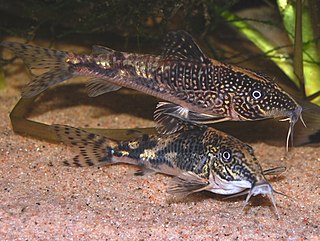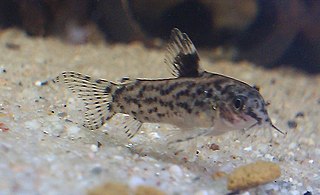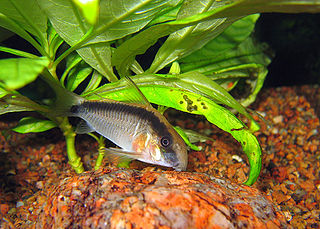
Callichthyidae is a family of catfishes, called armored catfishes due to the two rows of bony plates along the lengths of their bodies. It contains some of the most popular freshwater aquarium fish, such as many species in the genus Corydoras.

Hypostomus is a genus of catfish in the family Loricariidae. They are native to tropical and subtropical South America. H. plecostomus is the popular freshwater aquarium fish formerly known as Plecostomus plecostomus. The taxonomic structure of the Loricariidae is still being expanded by scientists. Hypostomus is a highly species-rich and widely distributed catfish genus.

Corydoras is a genus of freshwater catfish in the family Callichthyidae and subfamily Corydoradinae. The species usually have more restricted areas of endemism than other callichthyids, but the area of distribution of the entire genus almost equals the area of distribution of the family, except for Panama where Corydoras is not present. Corydoras species are distributed in South America where they can be found from the east of the Andes to the Atlantic coast, from Trinidad to the Río de la Plata drainage in northern Argentina. Species assigned to Corydoras display a broad diversity of body shapes and coloration. Corydoras are small fish, ranging from 2.5 to 12 cm in SL., and are protected from predators by their body armor and by their sharp, typically venomous spines.

Otocinclus is a genus of catfish in the family Loricariidae native to South America, commonly known as "dwarf suckers" or "otos". This genus, like other loricariids, is characterized by rows of armour plating covering the body, as well as the underslung suckermouth. They are generally small in size; O. tapirape is the smallest of the species (2.4 cm), while O. flexilis is the biggest (5.5 cm). These species have adaptations that allow them to breathe air. A duct forms at the junction between the esophagus and the stomach and expands into an enlarged, ring-like diverticulum, characteristic of this genus, which allows air-breathing. Otocinclus are popular aquarium fish, and they are often purchased as algae eaters. It is difficult to breed them in captivity, and only wild caught Otocinclus are available to hobbyists. This genus is widely distributed east of the Andes of South America, throughout the lowlands from northern Venezuela to northern Argentina, but are generally absent from the Amazon and the Orinoco lowlands.

The banded corydoras or bearded catfish is a subtropical freshwater fish belonging to the subfamily Corydoradinae of the family Callichthyidae. It originates in coastal drainages in South America from Rio de Janeiro to Santa Catarina, Brazil.
Corydoras narcissus, commonly known as the long nosed arched cory, is a freshwater fish belonging to the Corydoradinae subfamily of the family Callichthyidae, native to the Madeira and Purus river basins in Amazonian Brazil. It has a longer, more concave ("saddle-shaped") nose, but its color pattern resembles that also seen in a few other Corydoras species from the western Amazon basin, as well as Brachyrhamdia thayeria; they all have spiny fins with a painful but not dangerous venom and their similarity is an example of Müllerian mimicry. C. narcissus generally is an uncommon species in its range.

The hog-nosed catfish is a tropical freshwater fish belonging to the Corydoradinae sub-family of the family Callichthyidae. It is native to South America, and is found in the western Amazon basin in Ecuador and Peru. This species is traditionally placed in Brochis but the genus is a synonym of Corydoras. FishBase continues to recognize Brochis as a valid genus.

The sixray corydoras or false corydoras is a tropical freshwater fish belonging to the Corydoradinae sub-family of the family Callichthyidae. It originates in inland waters in South America, and is found in the upper Araguaia River basin in Brazil.
Aspidoras rochai or loach catfish is a tropical freshwater fish belonging to the Corydoradinae sub-family of the family Callichthyidae. It originates in inland waters in South America, and is found in coastal rivers in Ceará, Brazil.

Callichthys is a small genus of freshwater catfish in the Callichthyinae subfamily of the armored catfish family, and consists of 4 species from South America. The genus Callichthys is distributed in most freshwater drainages of South America.

Rineloricaria is a genus of freshwater tropical catfish belonging to the family Loricariidae. They are commonly called whiptail catfish because of the long filament that grows out of the tip of the caudal fin that is characteristic of the genus. With the exception of R. altipinnis from Panama, they are native to the rivers of northern and central South America. Some species are regularly seen in the aquarium trade.

Loricaria is a genus of armored catfish native to South America.

Scleromystax is a genus of fish in the family Callichthyidae endemic to small tributaries from several coastal river basins draining the southern and southeastern regions in Brazil. Most of the species of Scleromystax are highly sexually dimorphic; males have developed odontodes inserted in fleshy papillae on the preopercular-opercular region and the dorsal and pectoral fins are 2–3 times as long as those of females. S. salmacis is an exception, as its sexually dimorphic features are subtle and non-remarkable.
Lepthoplosternum altamazonicum is a species of catfish of the family Callichthyidae. It is found in the upper Amazon River basin in Peru and Brazil,
Lepthoplosternum pectorale is a species of catfish of the family Callichthyidae. It is found in Argentina, Brazil and Paraguay where it occurs in the Paraguay River.
Scleromystax salmacis is a species of catfish of the family Callichthyidae. S. salmacis has the southernmost distribution of its genus. It is known from the Mampituba River and Araranguá River basins in southern Santa Catarina State of Brazil, and the Ratones River, a small coastal river drainage in Florianópolis.
Corydoras fulleri, formerly identified as C116/115, is a tropical freshwater fish belonging to the subfamily Corydoradinae of the family Callichthyidae native to South America where it is found in two tributaries of the río Manuripe and a tributary of the río Madre de Dios, rio Madeira basin, Peru. It lives in a tropical climate in water with a temperature range of 22–26 °C (72–79 °F).

Ian Alexander McDonald Fuller is an English aquarist and ichthyologist.

Corydoras arcuatus is a species of freshwater fish in the armored catfish family Callichthyidae. It is restricted to the western Amazon basin, where only known from small blackwater or clearwater streams in the middle Juruá River basin, the Javari River basin and streams near Leticia in western Brazil, far northeastern Peru and far southeastern Colombia.












